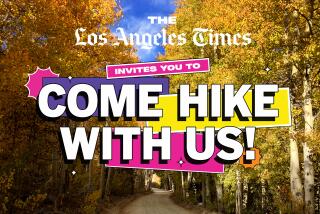Hikers, dodge that bullet
- Share via
Ah, autumn. Hikers are treated to cooler temperatures, clean air and the gentle rustling of brightly hued leaves. And sometimes the sharp sound of a gunshot. With hunting season upon us, is it also open season on hikers?
In California, the odds are in your favor when it comes to hunter safety -- although other states can’t boast the same. In the state, a hunter has never injured a nonhunter, at least officially, said Joe Gonzales, hunter education coordinator for the California Department of Fish and Game.
One reason: The state’s vast public lands allow hunters and hikers to keep a safe distance from one another. The other reason, fish and game officials say, is that the state requires all would-be hunters to pass a safety course before being granted a license.
This doesn’t mean accidents don’t happen. Last year in California, there were 19 incidents of hunters injuring other hunters or themselves, including two fatalities. The majority of incidents involved one hunter being hit by pellets from another hunter’s shotgun and, in a few cases, a hunter being mistaken for game. Most of the victims were not wearing blaze orange -- the eye-popping color that hunters know not to shoot at. After all, animals are not orange.
Chamois Anderson, a fish and game officer, is a rock climber who during hunting season takes the same safety measures hunters do. Since hunters are urged to wear an orange vest and hat to identify them in the field as hunters, she wears a bright-colored hat and clothing to make herself stand out. And, she points out, you can do the same for your dog.
Hunters tend to track game far from established hiking trails and usually hunt at dawn and dusk, when animals are foraging. Still, during hunting season, it’s often best not to venture too far off-trail -- and it’s usually a good idea to make some noise while hiking.
Keep in mind, too, that it’s not exactly a shooting gallery out there. “Hunters are not just firing randomly. They have to see their target through a scoping device and then shoot,” Anderson said.
These are reassuring words, but it still makes sense to take precautions, especially if hiking in popular hunting areas such as the Sierra foothills or the deer-hunting areas near Lake Tahoe that run along the state’s eastern border.
Some public lands have firearm restrictions, but most lands managed by the U.S. Forest Service and the Bureau of Land Management are open to hunting. Hunting is not allowed in state and national parks.
The 650,000-acre Angeles National Forest is a good example of public land that hunters and hikers use. The forest is laced with popular hiking trails, including a long portion of the Pacific Crest Trail. The forest’s thousands of acres of open country are favored by mule deer.
Even if you find the idea of hunting distasteful, it’s smart to know what’s being hunted and when the seasons run, Gonzales says. In California, the general hunting season (for all manner of weapons, from archery to rifles to muzzleloaders) for deer is just getting underway and runs through early to mid-November. In the hunting zone near Los Angeles, the general season runs from Saturday to Nov. 9. The Department of Fish and Game’s Web site, www.dfg.ca.gov, is a good resource to learn about who is hunting what and where.
Of course there are always yahoos and game poachers who openly flout state hunting laws. Yet, there has been a huge drop in hunting accidents over the years -- from 108 in 1956 to a fraction of that a year over the last few years. Gonzales attributes the decline to fish and game’s 10-hour safety course for first-time hunters. About 22,000 prospective hunters a year go through the program. About 90% pass, but not everyone goes on to get a license.
“The one thing we teach is to know your target,” Gonzales says. Carelessness is the cause of many accidents, so students learn to treat every gun as if it’s loaded. Prospective hunters also learn field and game laws -- no loaded guns in cars or campgrounds and no drinking alcohol while hunting. A certain “maturity level” is sought, says Gonzales, and often an instructor won’t pass a student if he or she gets a big negative when the instructor asks himself, “Would I hunt with this person?”
Gonzales is heartened by this year’s statistics. If the numbers stay on track -- only six hunting-related accidents so far in 2003 -- he says California will experience its lowest rate of reported hunting incidents in the state’s history.
That’s something that should help autumn recreationists sleep well at night.
To e-mail Julie Sheer or to read more of her columns, go to www.latimes.com/juliesheer.
(BEGIN TEXT OF INFOBOX)
Bargain hunting
Blaze-orange vests that scream “don’t shoot” can be purchased for you -- and your dog -- at most sporting good stores or online at www.cabelas.com and www.ruffwear.com.
More to Read
Sign up for The Wild
We’ll help you find the best places to hike, bike and run, as well as the perfect silent spots for meditation and yoga.
You may occasionally receive promotional content from the Los Angeles Times.






